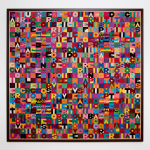
Alighiero Boetti Italian, 1940-1994
Oggi Decimo Giorno del Quarto Mese Anno Uno Nove Otto Nove, 1989
Embroidery
105 x 108 cm; (41 3/8 x 42 1/2 in.)
Copyright The Artist
